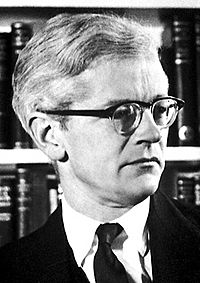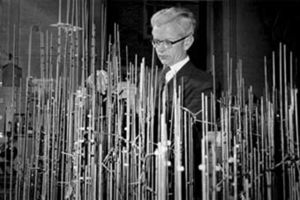John Kendrew facts for kids
Quick facts for kids
John Kendrew
|
|
|---|---|
 |
|
| Born |
John Cowdery Kendrew
24 March 1917 Oxford, England
|
| Died | 23 August 1997 (aged 80) Cambridge, England
|
| Education | Clifton College |
| Alma mater | University of Cambridge |
| Known for | Heme-containing proteins |
| Awards |
|
| Scientific career | |
| Fields | Crystallography |
| Institutions | Peterhouse, Cambridge Royal Air Force |
| Thesis | X-ray studies of certain crystalline proteins : the crystal structure of foetal and adult sheep haemoglobins and of horse myoglobin (1949) |
| Academic advisors | Max Perutz |
| Doctoral students |
|
| Other notable students | James D. Watson (postdoc) |
| Military career | |
| Allegiance | |
| Service/ |
|
| Years of service | 1941–1945 |
| Rank | Wing Commander (RAFVR) |
| Battles/wars | Second World War |
Sir John Cowdery Kendrew (born March 24, 1917 – died August 23, 1997) was an English biochemist and crystallographer. He was also a science leader. John Kendrew won the Nobel Prize in Chemistry in 1962. He shared this award with Max Perutz. They won for their important work on proteins at the Cavendish Laboratory. Proteins are tiny building blocks inside all living things.
Contents
Early Life and Education
John Kendrew was born in Oxford, England. His father, Wilfrid George Kendrew, studied weather patterns. His mother, Evelyn May Graham Sandburg, was an art historian.
John went to school at the Dragon School in Oxford. Then he attended Clifton College in Bristol from 1930 to 1936. In 1936, he started studying chemistry at Trinity College, Cambridge. He finished his degree in 1939.
World War II Service
When World War II began, John Kendrew first researched how chemicals react. Later, he joined the Air Ministry Research Establishment. There, he worked on radar, which helps detect objects. In 1940, he joined the Royal Air Force (RAF). He worked on planning military operations. He became a squadron leader in 1941 and an honorary wing commander in 1944. He left the RAF in 1945. After the war, he earned his PhD in 1949.
Discovering Protein Structures
During the war, John Kendrew became very interested in how living things work at a tiny level. He decided he wanted to study the structure of proteins.
Starting Crystallography Research
In 1945, he met Max Perutz at the Cavendish Laboratory in Cambridge. A scientist named Joseph Barcroft suggested that Kendrew study hemoglobin. Hemoglobin is a protein in blood that carries oxygen. Kendrew began comparing hemoglobin from adult and baby sheep.
In 1947, he became a Fellow at Peterhouse, Cambridge. The Medical Research Council (MRC) agreed to create a special research group. This group would study the tiny structures of biological systems. Sir Lawrence Bragg led this new unit.
Unlocking Myoglobin's Structure
John Kendrew and Max Perutz won the 1962 Nobel Prize for chemistry. They were the first to figure out the exact atomic structures of proteins. They used a method called X-ray crystallography. This work happened at the MRC Laboratory of Molecular Biology in Cambridge.
Kendrew focused on a protein called myoglobin. Myoglobin stores oxygen in muscle cells. It's like a tiny oxygen tank for your muscles.
At first, Kendrew tried to get myoglobin from horse hearts. But the crystals he got were too small to study well with X-rays. He then realized that animals that dive deep, like diving mammals, have a lot of myoglobin. By chance, he got a large piece of whale meat from Peru. Whale myoglobin gave him big, clear crystals.
Even with good crystals, the problem was still very hard. But in 1953, Max Perutz found a new way to solve it. This method was called "multiple isomorphous replacement." It involved comparing X-ray patterns from several crystals. One crystal was the original protein. Others had heavy metal atoms added to them in specific places. This helped them create a 3D map of the myoglobin molecule. By 1959, they had a detailed atomic model of myoglobin.
Later Career and Legacy
In 1963, John Kendrew helped start the European Molecular Biology Organization (EMBO). He also started and edited the Journal of Molecular Biology for many years.
In 1974, he helped create the European Molecular Biology Laboratory (EMBL) in Heidelberg. He became its first director. He was made a knight in 1974, so he became "Sir John Kendrew."
After leaving EMBL, Kendrew became the President of St John's College, Oxford at the University of Oxford. He held this job from 1981 to 1987. In his will, he left money to St John's College. This money helps students from developing countries study science and music. A building at St John's College, the Kendrew Quadrangle, is named after him.
A book about John Kendrew, called A Place in History: The Biography of John C. Kendrew, was published in 2020.
See also
 In Spanish: John Kendrew para niños
In Spanish: John Kendrew para niños


